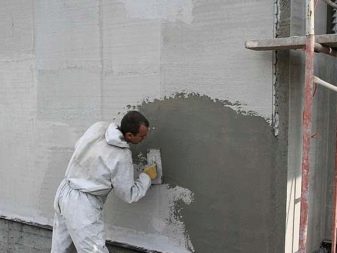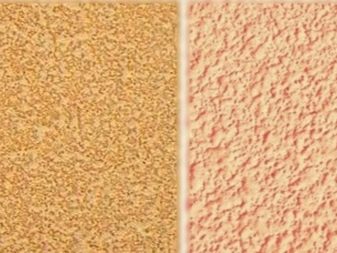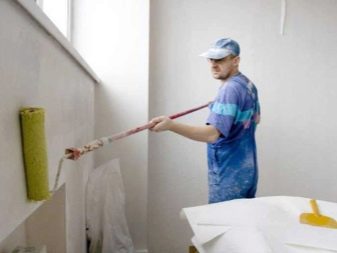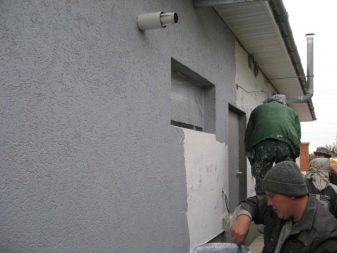Plaster under a fur coat: types of compositions and methods of application
Plaster material "coat" is known to almost everyone, despite its exotic name. Plaster of this type is used in the construction of buildings for many years, it can be seen on many buildings built during the Soviet era. At that time, the builders did not set themselves the task of the invention of an aesthetically attractive composition: they used sand and cement mixed in the necessary proportions and the addition of water. As a result of finishing the look of the walls was far from aesthetic appeal. We understand the modern diversity of this material and methods of its application.
Types of plaster
The use of plaster under the coat is relevant today.The builders are trying to save on materials with this method, which is not at all necessary, since at present you can find dry decorative plaster under a fur coat at any reasonable price at any hardware store.
The main advantage of this material is the fact that its operational properties are higher than those of the homemade counterpart. Due to the wide choice of finishing materials provided by trademarks for sale, you can find plaster in the form of ready-made mixture on the shelves of stores. It is sold mainly in buckets. The cost of this material is higher than the dry analog, as well as performance.
This decorative plaster received an unusual name due to its similarity with fur: it has a rough texture in finished form. This look is obtained thanks to the simple technology of mixing plaster with small stones. The size of the stone can be varied, it all depends on the purpose that is pursued during the repair. Using larger stones, you can get a more embossed wall. The opposite result can be achieved using small stones.
Plaster under the coat in the form of a dry mixture must be diluted with clean water at room temperature. This type of decorative plaster today has a white and gray color.It is a budget type of such finishing material, this option is used mainly to cover surfaces of a larger area. One of the main advantages of this material in the form of a powder is the ability to color the composition in any desired color.
The composition of the finished paste-like plaster in buckets includes synthetic polymers., which gives the composition increased softness and strength. Plaster of such a performance can be absolutely any color. It is advisable to use this expensive plaster for interior work (in order to save), and it can also be used for the final coating of surfaces. It is important to use expensive plaster and to cover certain parts of the interior (for example, arches, columns, borders). In this case, the concept of high prices is relative: if repairs are done for yourself, the use of quality materials should be the basic principle of work.
In addition to all the listed properties, the plaster decorative material for a fur coat has good thermal insulation and sound insulation properties, which justifies its name. It protects the walls from the negative influence of the environment.The use of this plaster greatly facilitates and accelerates the preparatory work, as it allows you to hide the defects of the working surface. Installation can be made independently (without participation of the qualified master).
It is important to mention that it is easy to restore damaged plaster during operation. The material allows this possibility, while the updated section will not break out of the general finishing canvas. A sufficient number of advantages of using plaster under a fur coat in wall finishing have been noted. For example, this composition can be colored with silicone or acrylic paint. Now you should understand the methods of applying it to the surface of the walls.
Application Methods
And the preparation of the working surface does not have to spend a lot of time. When working on the external surface of a building, it is sufficient to prime the surface with sufficient quality and dry it well. For surface treatment inside the house, you can walk on the surfaces with a primer twice: this will make the film formed on the surface during drying more durable.Apply each layer of soil only after the previous one has completely dried.
There are cases when the treated surface is initially covered in cracks and irregularities. In this case, these defects should be eliminated before priming the surface, only after that it can be primed. If the work is carried out indoors, the remains of the old finishing materials should be dismantled. Eliminate surface defects with the desired solution, but you do not need to grind anything, because the rough texture of the fur coat will hide all minor defects. After this, priming the surface is also required.
Plaster under the coat is applied to the surface in different ways. The choice of tool used depends on the application method. In total, you may need a large list of tools.
Sometimes it’s enough to prepare:
- textured roller;
- trowel (spatula);
- manual plaster sprinkler;
- industrial compressor;
- broom (in the form of a broom);
- ordinary stick.
This arsenal refers to a conservative and cheap (with the exception of the compressor) tool kit. It is suitable rather for finishing a small area.Currently, modern technologies of applying plaster are common, but these tools are more expensive. This article deals with small areas, so the listed list of tools is fine.
If the work uses a dry compound that must be diluted with water, you need to take into account some of the rules:
- Before mixing the material with water, it must be intensively stirred, as the stones can be distributed unevenly in the total mass.
- The plaster under the fur coat should be applied without a pause (in one approach) from one edge of the wall to the other (long pauses can contribute to the fact that there will be a noticeable transition between the layers).
- It is advisable to perform the work with an assistant who will prepare the mixture while you apply the plaster.
When working with the material with a spatula, you should immediately apply a layer of plaster, and then level it with circular (or forward and backward) movements with a trowel. As a rule, in one approach a plot of not more than 1 square meter is treated. m. During alignment, you can not hesitate: when the solution hardens, it is more difficult to get rid of visible defects in the lining.When working with finished materials in buckets it is necessary, as they quickly harden.
When applying plaster using a roller, you can use two methods of applying the composition. In the first method, the decorative material is applied like paint. Before that, it is diluted with water, then a pile roller is immersed in the finished mixture and painted on the surface with plaster. The second method is that the first plaster is applied to the surface with a spatula, then rolled with a fleece roller.
You can use a broom of twigs. A broom is immersed in the prepared material, after which the material is sprayed onto the wall when it hits the base of the broom on a stick. This is an old method, but effective and economical, although sometimes the end result can not be called accurate. It all depends on the qualifications of the master. Despair is not worth it. Even if the end result does not suit you, you can always modify the surface with a roller.
A sprinkler should be mentioned. Plaster sprinkler is a device with a container for ready-to-use material. Working with a sprinkler does not require special skills, this method is considered semi-professional.It is enough to direct the hole on the wall and twist the handle. So the solution begins to spray on the surface. This method involves the cash costs of the tool itself.
The compressor is used when applying plaster on the facade of the building: This work with large areas. In this case, it is irrelevant and unwise to use a roller, a broom. The compressor is a professional option, so its price is appropriate. Such a result, as with a compressor, cannot be achieved by economical methods: the work performed by a compressor is distinguished by a higher quality. If you need a perfect result, it is advisable to seek help from professionals who have the necessary set of tools.
Coloring
The main colors that are most sought after by professional craftsmen are white and gray. It is worth noting that other bright colors look very advantageous. However, buying colored plaster with the effect of a fur coat, you can spend a lot of money. In such a situation, you can come up with the following: you can paint the dried plaster in the desired color.
It should be noted that the plastered wall can quickly lose its fresh look and brightness from exposure to sunlight and moisture.Fresh chips on colored plaster require regular tinting, as any defects will immediately be evident. But in this situation there is a solution: you should add a little paint to the solution itself and mix thoroughly. However, it is advisable to initially purchase high-quality materials so as not to engage in minor repairs in the near future.
Putting plaster under a fur coat, see below in the video.


















































